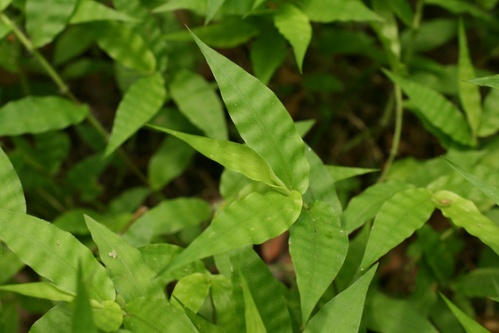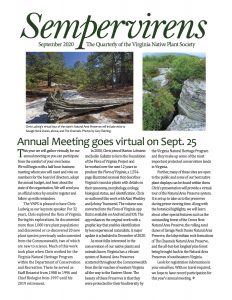November 16, 2015.
We have wavyleaf basketgrass! Fortunately, the picture is a stock photo, but Tom Dierauf pointed out some of our own when he visited in September. I didn’t get the import until he passed the word to Ruth Douglas, who let Devin Floyd know—we’re the beneficiaries of a network of experts—who filled us in on just how nasty the stuff is.
Here, from a post by Project Wavyleaf to the Virginia Native Plant Society’s website http://vnps.org/wavyleaf-basketgrass-help-stop-now/:
Wavyleaf basketgrass was first discovered in Maryland in 1996 in Patapsco Valley State Park, near Baltimore MD. It has since spread through Maryland and Virginia, showing many of the qualities of a successful and damaging invasive species. In some areas this shade-tolerant grass completely carpets the forest floor, leaving little room for native species. Its perennial life style enables it to emerge, year after year, through thick leaf litter; allowing it to colonize vast areas of forest inaccessible to annual invasive grasses like stiltgrass. Its insidious dispersal method of offering dozens of goo-covered seeds atop a spikey inflorescence ensures it hitches a ride on nearly anything mobile that brushes past: people, dogs and deer, definitely; small mammals and birds, probably. Also, nothing appears to eat it. Imagine the ecological consequences of large swaths of forest monopolized by an inedible understory.
Tom recalls seeing only a little of it near the entry road, in a small patch of Japanese stilt grass (another unwelcome guest, less invasive) It’s likely dormant now, but we’ll be on the lookout come spring.
Other news:
Devin, Rachel, and Ryan have planted three red cedars and two native fringe trees near the Quonset hut/future visitor center; also about 20 smaller short leaf pines among the Virginia pines along the path to the overlook and around the flat. They have collected seeds of showy skullcap, white thoroughwort, muhly grass, and sweet-scented goldenrod, among others, to propagate. The plan is to bring back these very local genotypes for transplanting in colonies next spring.
Hoping to get our 10,000 or so newly-planted meadow and wetland plants (mostly plugs) through the winter unscathed, I’ve treated them with the most reliable, long-lasting deer repellent I know: Plantskyd—ghastly stuff.
Armand has been spending his time removing what seems like (and actually may be) miles of greenbrier vine (invasive native), moving rocks around to outline the paths and parking spaces in the parking lot, uprooting hundreds more miscanthus (invasive alien) plants with a pickaxe, and chainsawing various deadwood around the paths. We’ll save for next time pictures of the completed #2 bridge, the completed tumble-stair, several completed smaller rock stairs, the completed #1 pole barn, and the almost completed parking lot.
We had a visit from Eric Bull, a woodworker from the Scottsville area who specializes in “equestrian furniture” (jumps and such), but also has major woodworking equipment and a willingness to build rustic benches for us. His suggestion is to make each of the benches from a different species of tree local to our area (we have 46 catalogued around the quarries) and locate each near a representative tree from which it was made. Great idea, right?

